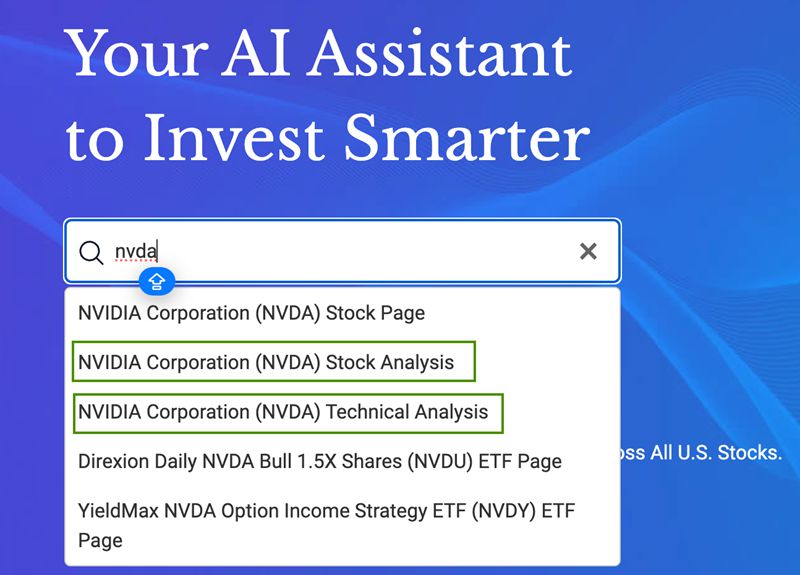20 Recommended Suggestions For Deciding On Ai copyright Trading Bot Websites
20 Recommended Suggestions For Deciding On Ai copyright Trading Bot Websites
Blog Article
Top 10 Tips For Evaluating The Accuracy And Performance Of Ai Platform For Predicting And Analyzing Stocks
Examining the accuracy and effectiveness of AI analysis and stock prediction trading platforms is crucial to ensure you're relying on a tool that can deliver solid insights and accurate predictions. Here are the ten most crucial tips to evaluate these platforms:
1. Backtesting Results
What to look for: Make sure the platform allows you to conduct back-testing in order to see how accurate its predictions were basing their predictions on the past data.
Why It's Important: Backtesting lets you verify the accuracy of an AI model. This can be done by comparing predicted outcomes with actual results from the past.
Tip: Choose platforms that let you customize the parameters for backtesting (e.g. time intervals or asset categories).
2. Real-time Performance Monitoring
What to Watch Out For What the platform does during real-time conditions.
What is important Real-time performance of an application is a more reliable indicator than the backtesting of historical data.
Tip : You can use a demo account, or a trial version of the program to monitor live movements in real time and then compare it with your forecasts.
3. Prediction Error Metrics
What to Look Out For: Measure prediction accuracy by measuring metrics like the Mean Absolute Error(MAE) and the Root-Mean Squared Error(RMSE) or Rsquared.
Why it is Important : These metrics offer a quantitative measure to assess how close predictions are to actual results.
Tip: Platforms that publicly reveal their data tend to be more transparent and trustworthy.
4. The Win Rate and the Success Ratio
What to look for: The platform's win ratio (percentage for accurate predictions) and the rate of success (profitability based upon the predictions).
Why is it important: High success rates and win percentages indicate greater accuracy in predicting the future and a higher chances of earning.
Be aware that no system can be 100% perfect.
5. Benchmarking against Market Indices
What to watch out for: Examine the performance and forecasts of the platform to important market indices.
Why it is crucial because it allows you to determine whether this platform outperforms (or underperforms) the overall market.
Find out if the performance is consistent over time, and not just in the short run.
6. Consistency on Market Conditions
What to look out for: How the platform performs when there are various market conditions.
Why it is Important It is important that the platform be able of performing in all kinds of market conditions, not only when the conditions are favorable.
Test the platform's predictions during volatile markets or market downturns.
7. Transparency in Methodology
What to Watch Out For What to Look Out For: Learn about AI models, algorithms, and techniques (e.g., neural networks, reinforcement learning).
Why it Matters: Transparency helps you evaluate the validity and reliability of scientific research.
Beware of platforms that employ models with "black boxes" without describing the process by which predictions are made.
8. Independent testing and User Reviews
What to watch out for: Read user reviews and independent testing and third-party evaluations.
What is important The independent testing and reviews provide unbiased insight into the platform's accuracy.
Tips: Look into forums such as Reddit, copyright, or financial blogs for reviews of user experiences.
9. Risk-Adjusted Returns
What to Watch Out For The platform's performance can be evaluated using risk adjusted metrics such as Sharpe Ratios or Sortino Rateios.
What is the significance of this measure measures the risk that is taken to realize returns. It gives an overall picture of the effectiveness.
Tips: A high Sharpe Ratio (e.g. over 1) indicates better risk-adjusted returns.
10. Long-Term Track Record
What to look for Check the performance of the platform over a long period (e.g. three years,).
What's the point? Long-term results are a better measure of reliability than the results from a short-term study.
Avoid platforms which only show the results of a short-term study or a cherry-picked achievement.
Bonus tip: Use the demo account
Try out the platform with an account for a demo to test how precise it can be in real time. This allows you to assess the accuracy and performance of the platform in real-time.
Following these tips can help you to evaluate the accuracy and performance of AI stock predicting platforms. This will enable you to choose one which best suits your trading needs and risk tolerance. Keep in mind that no platform is able to be trusted. Therefore, combining AI insights with your own research to the platform's predictions is usually the best choice. Follow the top continue reading about ai stocks for more info including trader ai intal, ai stock trading, ai stock picker, free ai tool for stock market india, free ai tool for stock market india, getstocks ai, stock analysis tool, best artificial intelligence stocks, ai for investing, chart ai trading and more.
Top 10 Tips For Assessing The Regulatory Conformity Of Ai Stock Predictive/Analytical Platforms
The regulatory compliance is a crucial element when it comes to considering AI stock predicting/analyzing trading platforms. Compliance assures that the system works within the legal framework, safeguards the privacy of users, and conforms to financial regulations, reducing the possibility of legal problems or financial sanctions. Here are 10 top tips to assess the compliance of these platforms.
1. Verify Licensing and Registration
Regulators: Make sure your platform is registered and regulated by the appropriate financial regulatory authorities (e.g., SEC in the U.S., FCA in the UK, ASIC in Australia).
Verify the broker partnership If your platform has a partnership with brokers and brokers, you need to make sure they are licensed and regulated.
Public records: Go to the website of the regulator to verify the status of registration as well as past violations.
2. Assess the privacy of your data Compliance
GDPR If you're serving or operating within the EU Make sure the platform is compliant with the General Data Protection Regulation.
CCPA: For users in California ensure compliance with the California Consumer Privacy Act (CCPA).
Data handling policies: Go through the policy of the platform's data privacy to make sure that it outlines exactly the way that user data is collected, stored and shared.
3. Evaluation of Anti-Money Laundering/AML Measures
AML policies: Ensure that the platform is equipped with strong AML policies in place to detect and prevent cash laundering.
KYC procedures: Find out whether the platform supports Know Your Customer (KYC) that verifies the identity of users.
Transaction monitoring: Check whether the platform monitors transactions for suspicious activities, and then reports it to authorities in charge.
4. Make sure that you are in conformity with Trading Regulations
Market manipulation: Make sure the platform is equipped with measures to prevent market manipulation, like spoofing or wash trading.
Order types: Ensure whether the platform is in compliance with rules regarding order types.
Best execution: Check if the platform is in line with the highest standards of execution, and ensures that trades are executed at the highest price available.
5. Cybersecurity compliance assessment
Data encryption - Ensure that the platform is using encryption to secure data in transit or at in rest.
Incident response. Verify whether the platform is equipped with a plan for dealing with data breaches and cyberattacks.
Certifications: Make sure the platform has cybersecurity certifications.
6. Evaluate Transparency and Disclosure
Fee disclosure: Make sure that the platform discloses clearly all fees, additional charges or hidden charges.
Risk disclosure - Make sure that the platform has clear risk disclosures. This is especially important when trading strategies have high leverage or risk.
Performance reporting: Determine if the platform provides transparent and accurate performance reports on its AI models.
7. Check the Compliance with International Regulations
Transparency in trading across borders: If you are trading internationally, ensure that the platform you use is in compliance with all applicable regulations.
Tax reporting: Verify whether the platform has tools or reports that assist users in complying with tax laws (e.g., FIFO rules in the U.S.).
Sanctions compliance: Ensure the platform adheres to international sanctions and doesn't allow trading with prohibited entities or countries.
8. Examine Record-Keeping and Audit Trails,
Transaction records: Make sure your platform has detailed records of every transaction, both for reasons of auditing and regulatory purposes.
Logs of user activity: Check whether the platform is logging the user's activity, such as logins, trades, and changes to the account settings.
Audit readiness: Ensure that the platform is equipped with all the documentation and logs necessary to pass a regulatory review.
9. Assess compliance with AI-Specific Regulations
Algorithmic trading rules: If you're using a platform which supports algorithmic trading ensure that it is compatible with relevant regulatory frameworks, such as MiFID II or Reg SCI which are in Europe and in the U.S.
Fairness and Bias: Check to determine if there are any biases that the platform can control and minimize within the AI model. This will ensure ethical and fair trade.
Explainability - Make sure that the platform is able to provide clear and concise explanations regarding AI-driven predictions, decision-making and more. in accordance with certain rules.
Examine the User Feedback and the Regulatory Histories
User feedback: Review reviews from users to determine the reputation of the platform for compliance with regulations.
Regulatory history - Check to determine if the website is associated with any prior penalties or violations of regulations.
Third-party Audits: Ensure that the platform has been subjected to third-party inspections to make sure the platform is conforming to all laws and regulations.
Bonus Tips
Consultations with a lawyer: You might want to consult a lawyer in order to determine whether the platform is in compliance with the applicable laws.
Trial period: Test the platform for free, or use the demo to check the compliance features and documentation.
Customer Support: Verify that the platform provides customer support for any queries or problems related to compliance.
These suggestions will assist you to determine the level of compliance for AI trading platforms which predict/analyze price of stocks. In this way you'll be able pick a trading platform that is legal, and also protects you. Compliance reduces legal risk and builds confidence on the platform. Read the most popular ai stocks to invest in for blog info including best ai for trading, canadian ai stocks, stock analysis tool, ai investing, getstocks ai, invest ai, chart ai trading, stocks ai, stock market software, copyright financial advisor and more.